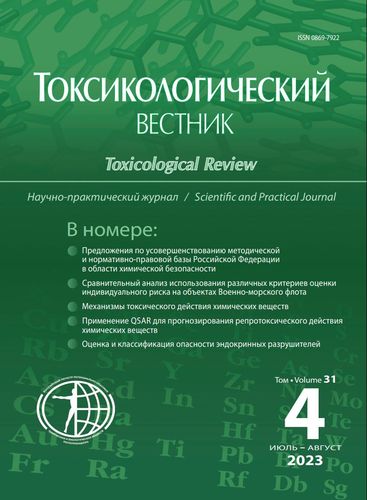The development of pre-implantation mouse embryos under the influence of sublethal doses of cadmium chloride on the maternal organism
- Authors: Noniashvili E.M.1
-
Affiliations:
- FSBSI «Institute of Experimental Medicine»
- Issue: No 4 (2023)
- Pages: 232-236
- Section: Original articles
- Published: 06.09.2023
- URL: https://vestnik.nvsu.ru/0869-7922/article/view/641490
- DOI: https://doi.org/10.47470/0869-7922-2023-31-4-232-236
- ID: 641490
Cite item
Full Text
Abstract
Introduction. Cadmium (CD) is a heavy metal widely distributed in the environment, when it enters the human body, it leads to the development of various diseases.
The aim of this work was to study the effect of sublethal doses of cadmium chloride on the preimplantation development of mouse embryos in vivo.
Material and methods. During the first three days of pregnancy, female mice were injected with 10 μM cadmium chloride (CdCl2). On the fourth day of the experiment, the embryos were explanted from the uterus and assessed development by the number of morules and blastocysts in each group and the number of blastomeres in the control and exposed embryos.
Results. Embryos exposed to cadmium chloride in utero passed the initial stages of cleavage and blastocyst formation faster than the control embryos. At the blastocyst stage, the rate of cleavage of exposed and control embryos statistically did not differ.
Limitations. The influence of the toxicant was assessed only on preimplantation mice embryos with intraperitoneal administration of the drug to mothers and in a single dose. Studies of mouse embryos at the postimplantation period of development would reveal in more detail the effect of the drug on embryogenesis.
Conclusion. Injections of sublethal doses of cadmium chloride to female mice at the debut of pregnancy force the development of embryos to the blastocyst stage.
Compliance with ethical standards. The conducted studies met the requirements of the Ethical Committee for the Use of Laboratory Animals, adopted by the Local Ethical Committee of the Federal State Budgetary Scientific Institution “IEM”, protocol No. 2/21 dated May 27, 2021.
Conflict of interest. The author declare no conflict of interest.
Funding. The study was not sponsored.
Received: April 24, 2023 / Accepted: July 29, 2023 / Published: August 30, 2023
About the authors
Ekaterina Mikhailovna Noniashvili
FSBSI «Institute of Experimental Medicine»
Author for correspondence.
Email: katinka.04@list.ru
ORCID iD: 0000-0002-2347-6920
For correspondence: Ekaterina M. Noniashvili, PhD, Senior Researcher, Laboratory of Molecular cytogenetics of mammalian development, Department of Molecular genetics, FSBSI «Institute of Experimental Medicine», 197022, St. Petersburg, Russian Federation.
e-mail: katinka.04@list.ru
Scopus Author ID: 6602403829; Researcher ID: E-4173-2014; e-Library SPIN: 1799-7736
Russian FederationReferences
- Zhang J., Tian Y., Wang W., Ouyang F., Xu J., Yu X., Luo Z., Jiang F., Huang H., Shen X. Letal Cohort profile: the Shanghai Birth Cohort. Int. J. Epidemiol. 2019; 48(1): 21.
- Nishijo M., Satarug S., Honda R., Tsuritani I., Aoshima R. The gender differences in health effects of environmental cadmium exposure and potential mechanisms. Mol. Cell. Biochem. 2004; 255: 87–92.
- Barker D., Eriksson J., Forsen T., Osmond C. Fetal origins of adult disease: Strength of effects and biological basis. Int. J. Epidemiol. 2002; 31: 1235–9.
- Barker D.J., Clark P.M. Fetal undernutrition and disease in later life. Rev. Reprod. 1997; 2: 105–12.
- Lin H.C., Hao W.M., Chu P.H. Cadmium and cardiovascular disease: An overview of pathophysiology, epidemiology, therapy, and predictive value. Rev Port Cardiol (Engl Ed). 2021; 40(8): 611–67.
- Fagerberg B., Barregard L., Sallsten G., Forsgard N., Ostling G., Persson M., et.al. Cadmium exposure and atherosclerotic carotid plaques – Results from the Malmö diet and Cancer study. Environ Res. 2015; 136: 67–74. https://doi.org/10.1016/j.envres.2014.11.004
- Noniashvili E.M., Chan V.Ch., Grudinina N.A., Sofronov G.A., Eprintsev A.T., Patkin E.L. Features of the development of preimplantation mouse embryos in the presence of low doses of cadmium chloride in vitro. Vestnik Voronezhskogo gosudarstvennogo universiteta. Seriya: Khimiya. Biologiya. Farmatsiya. 2019; 1: 48–55. (in Russian)
- Dalton T., Fu K., Enders G.C.,Palmiter R.D., Andrews G.K. Analysis of the effects ofoverexpression of metallothionein-1 intransgenic mice on the reproductive toxicology of cadmium. Environmental Health Perspectives. 1996; 1041: 68–76.
- Dyban A.P. Improved method for chromosome preparationsfrom preimplantation mammalian embryos, oocytes or isolated blastomeres. Stain Technology. 1983; 58(2): 69–72. https://doi.org/10.3109/10520298309066756
- Sakamoto M., Yasutake A., Domingo J.L., Chan H.M., Kubota M., Murata K. Relationships between trace element concentrations in chorionic tissue of placenta and umbilical cord tissue: potential use as indicators for prenatal exposure. Environ Int. 2013; 60: 106–11.
- Llanos M.N., Ronco A.M. Fetal growth restriction is related to placental levels of cadmium, lead and arsenic but not with antioxidant activities. Reprod.Toxicol. 2009; 27(1): 88–92.
- Piasek M., Blanusa Kostial K., Laskey J.W., Placental cadmium and progesterone concentrations in cigarette smokers. Reprod. Toxicol 2001; 15: 673–81. https://doi.org/10.1080/15287394.2014.915779
- Piasek M., Micolic A., Sekovanic A., Grgec A.S., Jurasovic J. Cadmium in placenta – a valuable biomarker of exposure duringpregnancy in biomedical research. J. Toxocol. Environ. Health. 2014; 77(18): 1071–4. https//doi.org/10.1080/15287394.2014.915779
- Guo, J., Wu, C., Qi, X., et al. Adverse associations between maternal and neonatal cadmium exposure and birth outcomes. Science of The Total Environment. 2016; 16: 31934–9.
- Jarup L., Rogenfelt A., Elinder C.G., Nogawa K., Kjellstrom T. Biological half-time of cadmium in the blood of workers after cessation of exposure. Scand. J. Work Environ Health. 1983; 9: 327–31.
- Turgut S., Kaptanoglu B., Turgut G., et al. Effects of cadmium and zinc on plasma levels of growth hormone, insulin-like growth factor I, and insulin-like growth factor-binding protein 3. Biol Trace Elem Res. 2005; 108(1–3): 197–204.
Supplementary files









